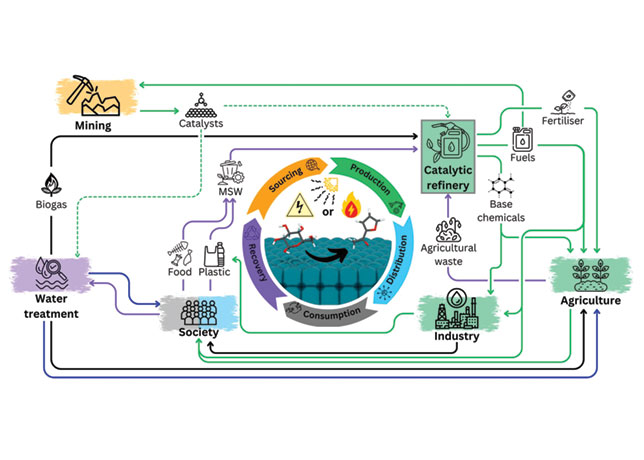
 Sustainable resource management in the circular economy with emphasis on resource recovery and waste reducation Source: ELSEVIER
Sustainable resource management in the circular economy with emphasis on resource recovery and waste reducation Source: ELSEVIER
The chemical industry is a cornerstone of global development, driving innovation, and providing essential products that support our modern way of life.
However, its reliance on unsustainable fossil resources has posed significant threats to global ecosystems through climate change and chemical pollution.
A new commentary published in Cell Press’ OneEarth co-authored by Griffith University researchers puts forth a transformative solution: catalysis to leverage sustainable waste resources, ushering the industry from a linear to a circular economy.
'If we look at recent statistics, the chemical industry contributes a staggering US$5.7 trillion to the global economy and sustains 150 million jobs worldwide, excluding refined fossil fuels,' says Professor Karen Wilson, one of the lead authors and Director of Griffith’s Centre for Catalysis and Clean Energy.
'But it remains the largest industrial energy consumer and the third-largest emitter of direct CO2 emissions globally.'
In 2022, the industry emitted 935 million metric tons of CO2 during primary chemicals production. Moreover, its operations have led to significant water contamination and the release of toxic chemicals into the environment, perpetuating a cycle of ecological harm.
Co-lead author Professor Adam Lee, also based at Griffith, says: 'Catalytic processes could minimise reliance on finite fossil fuels and curb CO2 emissions significantly by harnessing agricultural, municipal, and plastic waste as feedstocks.
'This feedstock transition not only mitigates environmental damage but also addresses vulnerabilities in the industry's supply chain, which are susceptible to geopolitical and natural disruptions.'
Professor Wilson says: 'Catalysis has historically played a key role in transforming fossil resources into essential fuels and products, and now offers a beacon of hope for revolutionising the chemical industry and promoting a circular economy.'
However, the authors acknowledge that this vision demands concerted innovation in catalyst formulation and process integration.
'Prioritising Earth-abundant elements over precious metals will unlock sustainable catalytic systems for the efficient conversion of organic waste into benign and recyclable products,' Professor Wilson says.
'Already, pioneering initiatives such as the co-location of different industries in Kalundborg, Denmark to foster symbiosis have demonstrated new collaborative models to improve resource efficiency and waste reduction.'
'Catalysis offers a pathway towards sustainability, enabling us to transform waste into valuable resources and pave the way for a circular economy,' Professor Lee adds.
In the OneEarth commentary, the team explored sources of catalysis for sustainable and circular chemical processes through the following lenses:
• Catalysis to enable waste biomass utilisation
• Catalysis for circular polymers
• Catalysis to remediate chemical pollution









































































